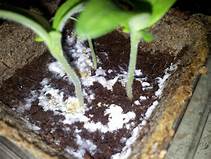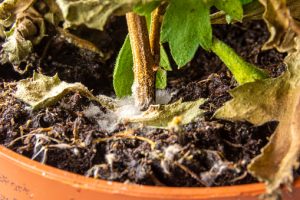Houseplants mold on soil can be removed. It is not always easy or without consequences for the plants, but if you persevere and apply the necessary treatments, you can save the spore-affected plants.
Moldy soil in pots is common as a result of overwatering, poor drainage, and the use of soil rich in organic matter. Excess water will encourage mold growth if you used soil with a high compost content. Compost substances promote mold multiplication, so it is best to transplant the plant in clean soil.
Often, what is visible on the surface of the soil is only a small portion of what is in the pot, and the mold spreads throughout the soil. Sometimes contamination begins at the surface, and removing a few centimeters of soil layer is all that is required to correct the situation.
Flowers maintenance
You have several options, but everything begins with an examination of the plant and the soil. Act in response to what is happening to your plant at all times.
Mold can attack houseplants in the winter. Mold easily forms in pots in hot and humid environments, which are less ventilated on cold days, and attack the leaves and flowers.
White or yellow spots appear sporadically on the leaves or on the surface of the soil as the first signs of mold. Take action right away because it is easier to get rid of it in the early stages. If the mold spreads throughout the pot and onto the leaves, it will be more difficult to save the plant.

White mold on potted soil
Mold treatment – Effective Solutions
When you notice white or yellow spots on the earth’s surface, clean it thoroughly with a spoon and spray it with a weak solution of water and lemon juice. Lightly dig the soil to allow it to dry faster and to ventilate the room. If it persists, sprinkle a thin layer of dry and crushed horsetail on the surface of the pot.
Clean the mold stains with a clean cloth and distilled water first, if they have already appeared on the leaves. To prevent mold spores from spreading, use another piece of cloth for each leaf.
If the mold-affected leaves are severely damaged, it is best to remove them in order to save the healthy ones. Then, from a safe distance, spray a 9:1 solution of distilled water and hydrogen peroxide. Apply only once a week to avoid overwatering the plant.
A teaspoon of baking powder, a few drops of bleach, and a liter of water can also be used to make an effective mold-killing solution. Mix thoroughly, then apply a thin layer of the solution to the affected areas.
How to Avoid Mold
Ventilate the areas where the plants are kept on a daily basis, even if some of them are more sensitive to cold. Changing the temperature for a short period of time, up to an hour, has no effect on them.
Plants that do not require a lot of water should be watered less frequently. During the winter, most houseplants go into a vegetative state and can only be watered once a week. Plants that bloom in the winter months, such as orchids, Christmas, and cyclamen, are an exception.
Tropical plants require spraying, especially if kept near heat sources. Check the backs of the leaves and the soil in the pots for mold caused by water spray on a regular basis. Remember to only sprinkle them with distilled water.
How to Deal with Mold in Potted Flowers’ Soil
Take action right away if the soil in the pot is covered with a thin layer of mold! Mold will attack your favorite flowers and plants, causing them to die in a matter of weeks.
Mold frequently appears above potted soil if the plants are kept in a damp, cold environment or if they are overwatered. Molds and fungi, which can be identified by their white, yellow, or green color, attack pots kept in poorly ventilated rooms during the winter. Mold spreads quickly from the ground to the roots and stems of flowers, causing them to rot in a matter of days.
What Room Flowers are Mold-resistant?
It may sound unbelievable, but some flower species are immune to fungi! Here are some houseplants you may not have to be concerned about:
- Ardisia
- Adenium is a metal.
- Glechoma
- Caladium is a mineral.
- Neoregelia
- Siderasis
- Cyperus is a plant.
Important! Keep in mind that the most important factors for mold development are dirt and moisture. Fungi and bacteria will bother you less if your home is clean and dry.
How do we Combat Mold?
Mold can be removed using a variety of methods, both modern and traditional. We’ve compiled a list of some of the most effective.
Method No. 1
The issue with mold is that we usually only see the “tip of the iceberg” with our naked eyes. Mold spreads not only on the surface but also below the surface. If you notice mold, you should immediately do the following:
• Mold should be used to remove the top layer of soil.
• Add fresh, clean, and healthy soil.
• Important! This prevents mold from entering the plant’s roots and killing it.
Method No. 2
This method will not only combat mold in the pots, but it will also fertilize the soil.
• Remove the soil’s top layer
• Mix in humus and leaf soil.
• Replace the soil.
In this manner, the mushrooms are removed, the soil is loosened, and the soil is fertilized.
Method No. 3
Do the following if you have expanded clay on hand:
• Remove the soil’s top layer
• Replace the soil.
• Mix in expanded clay
The idea is that if the fungus reappears, it will settle on the clay, which can be easily removed and washed.
Important! Replacing the topsoil has the effect of slowing mold growth. However, the safest course of action would be to completely replace the soil and relocate the plant to a new pot.

Mold on a houseplant in a pot from waterlogging of the soil and lack of fresh air is covered with mold
Methods for Dealing with Mold on the Ground
To get rid of mold on the ground, transplant the plant into another pot
If you use new soil, new pots, and treat the plant with a fungicide, to remove the spores that have most likely reached the leaves and shoots, you have most likely solved the problem. That entails keeping all of these elements in mind.
The soil must be completely replaced with one that is sterile. If you save even a small portion of it and there are spores in it, it quickly contaminates the entire pot.
The pot is a transmission vector as well. If you use the same pot, it must be thoroughly washed and disinfected, as well as sprayed with an antifungal solution. You can immerse the pot in a solution of 9 parts water and 1 part chlorine for 10 minutes. Then thoroughly rinse.
Before replanting, the roots, leaves, and stems are thoroughly cleaned of contaminated soil.
To remove mold, dry the soil
If the contaminated old earth has been sterilized, it can be reused by placing it in a tray and placing it in a heated oven.
Mold spores are also killed by the sun’s ultraviolet rays, according to research. So, in the summer, you can spread the soil in the sun until it dries completely.
In less severe cases of mold contamination on potted soil, the sun-drying method can be effective.
You can spray the soil with a solution of water and baking soda while it is left in the sun.
Remove the mold and apply a fungicide
When mold on the ground is only found on the surface in less severe cases, the contaminated layer can be carefully removed. Wipe the plant down with a damp cotton cloth to remove any remaining mold.
The plant will then be protected by the application of a fungicide. You can spray the plant and soil with phytopharmacy products or homemade solutions such as baking soda solution (a teaspoon dissolved in a liter of water).
To keep mold from growing on the ground, use natural antifungals
You can use organic solutions more as a preventative measure to avoid mold on the soil in the pot. This category includes water solutions containing lemon juice or apple cider vinegar, as well as ground cinnamon. The first two should be used with caution in plants that are sensitive to acidic soil.
Cinnamon can be mixed into the ground or sprinkled on top, but it should never be placed in large quantities.
Helpful Hints
- Loosen the soil more frequently in autumn, when the microclimate of the house changes that encourage the growth of mold.
- Fill the new soil with activated charcoal pellets.
- Fungicide solutions should be applied to the soil.
- To prevent the growth and development of fungi, sprinkle 1 teaspoon of lemon juice dissolved in 1 glass of water on the soil.
- 1-2 times per month, water the room flowers with potassium permanganate solution.
Follow these tips and take care of your room flowers so that you can enjoy their beauty and health for a very long time.




